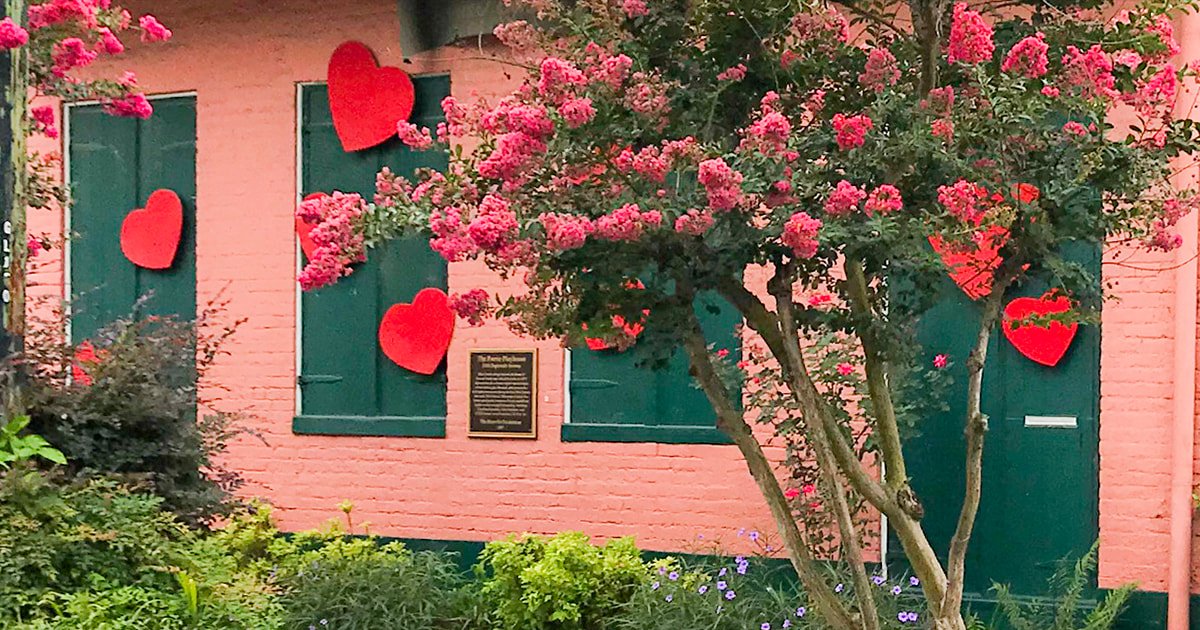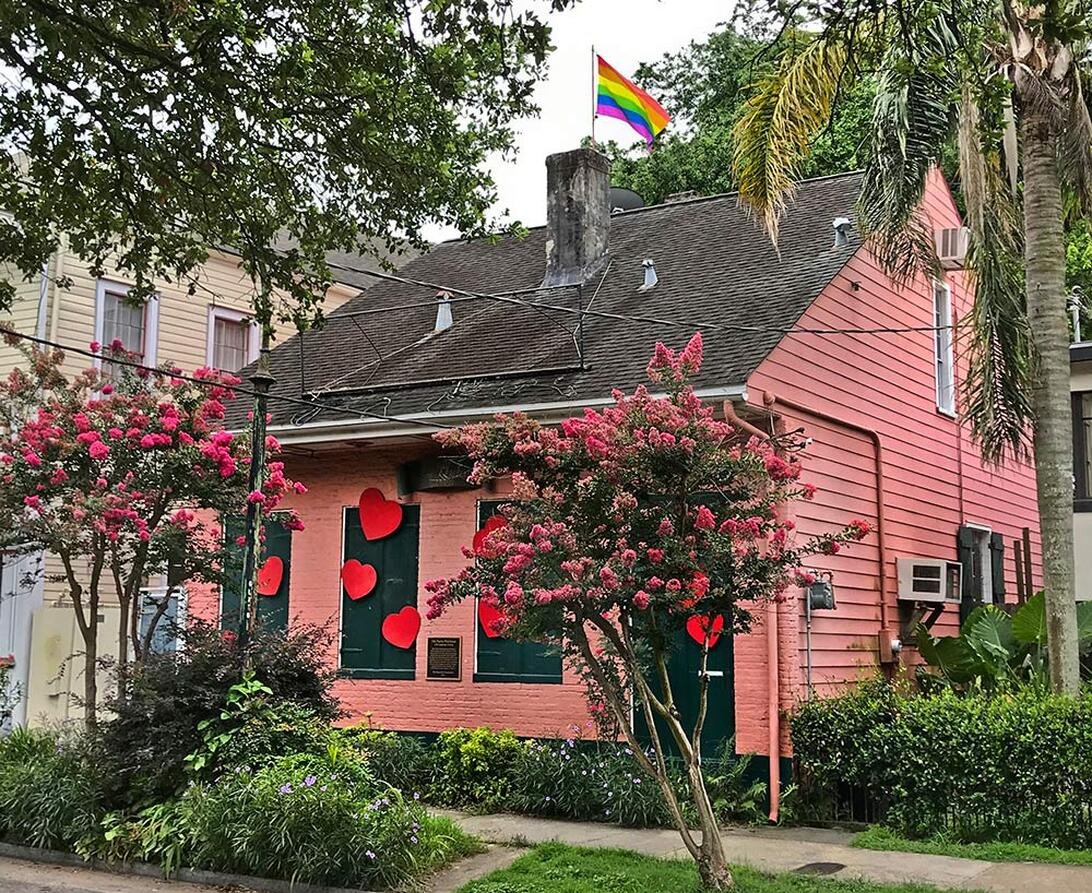Lion in Winter: A Tribute to Stewart Butler
Stewart Butler's biographer marks the March 2020 passing of this legendary New Orleans LGBT+ activist.
- by Frank Perez
In 2010 I found myself standing on Esplanade Avenue before a Creole Cottage with red hearts on its reddish front facade. A rainbow flag graced the roof along with a sign that read “Peace on earth.” A banner declared, “End the War.” On the front of the house, a historical marker reads:
The Faerie Playhouse
1308 Esplanade Ave.
This Creole Cottage became the home of Stewart Butler and Alfred Doolittle in 1979 and was the site of many organizational meetings in the lesbian, gay, bisexual, and transsexual civil rights movement during the late 20th Century and early 21st Century. The garden behind this home contains the remains of many significant leaders in that struggle for equality, including Charlene Schneider, John Ognibene, and Cliff Howard, as well as artist J.B. Harter.
The Bienville Foundation
2007
The Faerie Playhouse, photo by Ellis Anderson
The Faerie Playhouse, photo by Ellis Anderson
The scent of marijuana drifted onto the sidewalk from the alley leading to the back courtyard as the alley gate opened. I was about to meet Stewart Butler. He materialized out of a thick haze of cannabis smoke, as if conjured by some strange magic.
The old gay wizard, 80 at the time, stood before me with his two dogs - Putz, an English Springer Spaniel, and Holly, a mix. All three smiled at me warmly.
He was not tall but had a commanding presence. Think Benjamin Franklin as a hippy. His shoulder-length hair draped from a purple and gold fishing cap. His eyes were a piercing, yet gentle, blue. His t-shirt read, “Use me, Dump me, Crush me, Melt me, Use me again. Glass recycles.” Around his neck were a cross, the Rastafarian colors and a marijuana leaf. He invited me inside and, as he poured my coffee said, “There are many spirits in this house.”
I believed him.
The Faerie Playhouse, photo by Ellis Anderson
He then told me about Alfred, his lover and soul-mate of 35 years. The two had met in 1973 during Carnival season. Stewart and a friend were bar-hopping in the Quarter when they ran into Alfred, who had just arrived in town. At Café Lafitte in Exile, the venerable old watering hole located at the corner of Bourbon and Dumaine, Alfred whispered sweet obscene nothings in Stewart’s ear. Stewart was smitten.
“He looked just like Prince Valiant,” Butler recalled.
The two left Lafitte’s and made their way back to Stewart’s home. Alfred told him, “You’ll probably throw me out in the morning like the rest of them.” But Stewart didn’t throw him out. Alfred and Stewart remained together until Alfred’s death in 2008.
Theirs was a relationship that would shape the course of LGBT+ history.
Alfred and Stewart, photo courtesy Ron Joullian
Alfred hailed from a prominent San Francisco family. When Alfred was diagnosed with schizophrenia as a young man, his family put him in an institution. Alfred had other plans and escaped. He had always loved to travel. A few years earlier, in Paris, he lived briefly in the fabled Beat Hotel, where he met Allen Ginsberg, Peter Orlovsky, Brion Gysin, Ian Sommerville, Gregory Corso, Harold Norse and William S. Burroughs. He had an affair with Norse, who gifted Alfred with a few of his famous acid drawings. Alfred’s period as a global flaneur ended when he came to New Orleans and met Stewart.
Alfred and Stewart, photo courtesy Ron Joullian
A few months after connecting, Stewart and Alfred were at the Up Stairs Lounge at the corner of Iberville and Chartres streets the night an arsonist set fire to it. Butler was a regular at the bar and often took his dog, Jocko, to the Up Stairs. The dog, much to the delight of the other patrons, liked to drink vodka and milk out of a bowl. On the fateful night of the fire, Stewart and Alfred left the bar just minutes before flames erupted.
A few doors down, at Wanda’s bar, Stewart and Alfred had not even settled in when they heard the sirens. The scene they encountered outside was horrific. Word of the fire had spread quickly, and a throng of people gathered in the streets as mayhem ensued.
Years later, Stewart recalled that one of the most difficult things was going to work the next day and pretending to be unaware or unconcerned with the tragedy. Most workplaces at the time doubled as closets and while the demimonde of the French Quarter knew Stewart was gay, his boss and co-workers did not.
Surviving the fire that night was just one of a lifetime of remarkable moments in Stewart Butler’s life. Butler, with Alfred’s help, would go on to become one of the most consequential LGBT+ activists in New Orleans history.
The plaque commemorating the tragic Up Stairs fire at 604 Iberville. Click here to see a photo essay of the 2020 anniversary service. Photo by Andrew Simoneaux
Born in 1930, Butler grew up in New Orleans and at the age of 12 moved to Carville, La., where his father took a job at a leprosarium. Coming of age in a colony of Hansen’s disease patients gave Stewart a unique understanding of marginalized communities and helped shape an abiding compassion for the less fortunate.
After a stint at Louisiana State University, Butler served in the army before moving to Alaska, where he finished his education and became involved in labor politics. He was elected to the Alaskan Territorial Senate, but Alaska’s admission to the union nullified his election before he could take office.
Upon returning to New Orleans in 1964, Stewart lived from pillar to post for a few years. From 1965 to 1968, he lived in a total of 12 different places, including five in the French Quarter, four along Esplanade Avenue. Several roommates came and went. During this time, he worked various odd jobs as a busboy, waiter and a draftsperson for three land surveyors.
photo by Vince Santiago
When Alfred inherited his fortune, Stewart retired and became a full-time activist. He joined the Gertrude Stein Society, which served as a forerunner of sorts to LAGPAC (Louisiana Lesbian and Gay Political Action Caucus). Butler was a charter member of LAGPAC and played a key role in the 1991 passage of a New Orleans City Council non-discrimination ordinance. LAGPAC was the first gay rights group in Louisiana and Stewart was at its heart.
He was also at the forefront of the transgender rights movement long before it became fashionable. Through his involvement with PFLAG (Parents and Friends of Lesbians and Gays), he and Courtney Sharp led a successful campaign to have transgender people included in the national PFLAG mission statement.
Stewart also participated in HIV/AIDS activism, criminal justice reform, voter registration drives and a dozen other causes. In 1987, he led a protest against the Pope’s visit and the following year, he helped organize a protest against the Republican National Convention.
photo by Vince Santiago
More recently, in 2012, he called a number of people together and expressed his desire to do something about preserving local queer history. Thus, the LGBT+ Archives Project of Louisiana was born. A statewide collective, the LGBT+ Archives Project collaborates with universities, libraries, museums and archival repositories around the state to preserve materials that chronicle the LGBT+ community in Louisiana.
Stewart died in his sleep at the Faerie Playhouse on March 5, 2020. I had a chance to visit with him a few hours before he passed. I was struck by the weight of history this man shaped and the countless lives he touched. He truly was a lion in winter.
R.I.P., Stewart. And tell Alfred hello.
Alfred and Stewart, photo courtesy Ron Joullian











